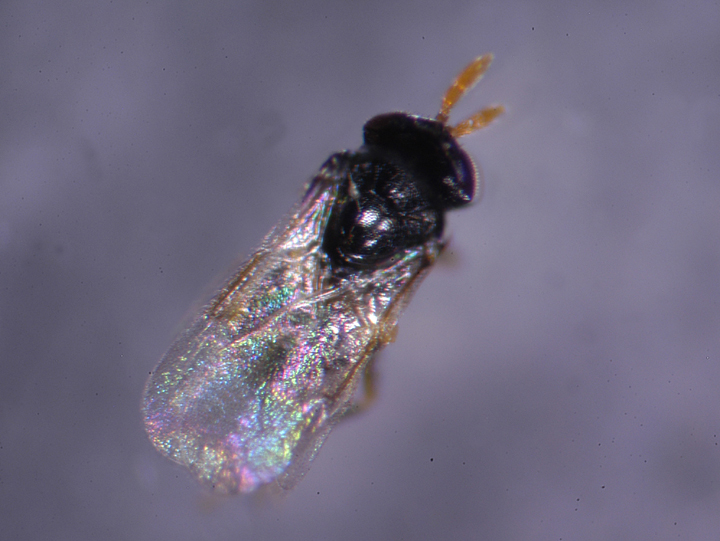by Elizabeth H. Beers, Stanley C. Hoyt, and Michael J. Willett, originally published 1993; revised March 2010 E. Beers
(Hymenoptera: Eulophidae)

This small wasp, native to the northeastern United States, parasitizes woolly apple aphid by laying its eggs directly into the body of the aphid. A. mali was introduced into the Pacific Northwest in 1928 at Hood River and has been introduced or has spread naturally to other Pacific Northwest fruit districts. It has been introduced successfully in many apple growing areas of the world and was considered one of the early success stories of biological control.
Hosts
While it has been reported to parasitize other aphid species, its primary economic value is as a woolly apple aphid parasitoid.
Life stages
Egg
The egg, which measures about 1/600 to 1/200 inch (0.07 to 0.21 mm), is inserted singly into the body of the woolly apple aphid.
Larva
The larva, which develops inside the aphid’s body, is elongated or shield shaped. The body color is bright yellow, with red eyes.
Pupa
The pupa is generally smaller than the larva. The thorax is black, and the outlines of legs and other appendages become visible as the pupa develops. The pupal stage is also spent inside the aphid’s body.
Adult
The adult is a tiny black wasp (slightly shorter than the woolly apple aphid) with short antennae. The membranous wings are folded flat over the back, and extend beyond the tip of the abdomen. It is inconspicuous in the orchard, jumping rather than flying and preferring to hide under leaves.
Life history
A. mali overwinters as a full grown larva or pupa inside a dead (mummified) body of a woolly apple aphid. Diapause commences in October, and is complete by late March. Emergence of adults corresponds with the start of nymph production by the woolly apple aphid in the spring.
In the early stages of development, there are no external signs of parasitism. The aphid host may continue to grow and develop and even produce a few young after being parasitized. The most visible signs of parasitism by A. mali are hardened, black, woolly apple aphid mummies with a characteristic circular exit hole cut by the adult parasite as it emerges from the aphid. The female inserts her egg into the lower surface of the abdomen, sometimes feeding on the body fluids that exude from the puncture. The egg hatches in about 3 days, and larval development takes about 10 to 12 days. The parasitoid pupates in the body of the aphid, and the emerging adult chews a neat, round exit hole in the back. The total life cycle takes 20 to 25 days. There are 6 to 7 generations of A. mali per year. Peak activity of adult parasitoids corresponds with peaks in woolly apple aphid nymph production in the spring and fall. A. mali only parasitizes woolly apple aphids on the above-ground parts of the tree.
Monitoring
Look for woolly apple aphid mummies with circular exit holes. Mummies are usually noticed after the pest has been controlled and no predator/prey ratios have been established to predict future control based on the number of mummies.
Management
A. mali, along with generalist predators, may provide control of woolly apple aphid unless disrupted by orchard pesticides. A. mali may not provide acceptable control after mild winters, when large woolly apple aphid populations survive. Research in Washington indicates that a large complex of generalist predators, including lady beetles, syrphid fly larvae, green lacewings, and Deraeocoris brevis, is at least as important as A. mali. Cultural practices that encourage these predators will enhance biological control of woolly apple aphid.
Aphelinus mali Gallery
References Consulted
Asante, S. K., and W. Danthanaryana. 1992. Development of Aphelinus mali, an endoparasitoid of woolly apple aphid, Eriosoma lanigerum, at different temperatures. Entom. Exp. Appl. 65: 31-37.
Bodenheimer, F. S. 1947. Studies on the physical ecology of woolly apple aphis (Eriosoma lanigerum) and its parasite, Aphelinus mali, in Palestine. Bull. 43, Rehoboth Agricultural Experiment Station, Palestine.
Evenhuis, H. H. 1958. Ecological investigations on the woolly aphid, Eriosoma lanigerum (Hausm.), and its parasite Aphelinus mali (Hald.) in the Netherlands. Tijdschrift over Planteziekten. 64: 103.
Lundie, A. E. 1924. A biological study of Aphelinus mali Hald., a parasite of the woolly apple aphid Eriosoma lanigera Hausm. Memoir 79, Cornell University Agricultural Experiment Station, Ithaca, NY.
Mueller, T. F., L. H. M. Blommers, and P. J. M. Mols. 1992. Woolly apple aphid (Eriosoma lanigerum Hausm., Hom., Aphidae) parasitism by Aphelinus mali Hal. (Hym., Aphelinidae) in relation to host stage and host colony size, shape and location. J. Appl. Entomol. 114: 143-154.
Walker, J. T. S., S. C. Hoyt, D. P. Carroll, and G. V. Tangren. 1988. Influence of constant and alternating temperatures on woolly apple aphid (Homoptera: Eriosomatidae) and its parasitoid Aphelinus mali (Haldeman) (Hymenoptera: Aphelinidae). Melanderia. 46: 37-47.



